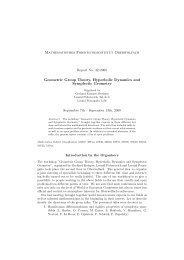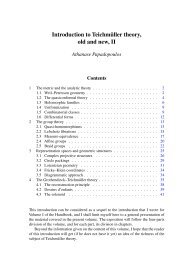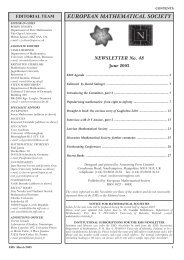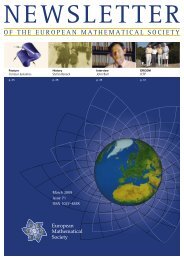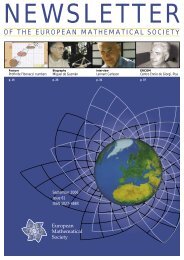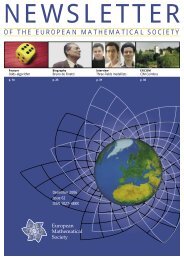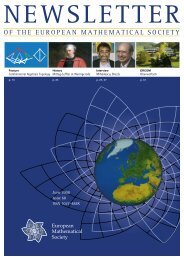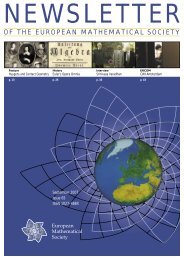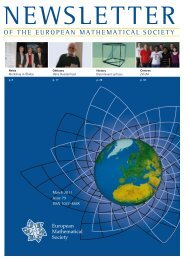EMS Newsletter June 2010 - European Mathematical Society ...
EMS Newsletter June 2010 - European Mathematical Society ...
EMS Newsletter June 2010 - European Mathematical Society ...
Create successful ePaper yourself
Turn your PDF publications into a flip-book with our unique Google optimized e-Paper software.
Israel Moiseevich Gelfand<br />
Vladimir Retakh<br />
Israel Gelfand, a mathematician compared by Henri Cartan<br />
to Poincare and Hilbert, died in New Brunswick, New Jersey,<br />
USA, on 5 October 2009.<br />
Israel Moiseevich Gelfand was born on 2 September 1913<br />
in the small town of Okny (later Red Okny) near Odessa in the<br />
Ukraine. There was only one school in town but Gelfand was<br />
lucky enough to have a good and encouraging mathematics<br />
teacher (one of his classmates David Milman also became a<br />
mathematician). In 1923, the family moved and Gelfand entered<br />
a vocational school for laboratory technicians. However,<br />
he was expelled in the ninth grade as a son of a “bourgeois element"<br />
– his father was a mill manager.<br />
In his early years, Gelfand lived in total mathematical isolation.<br />
The only books available to him were secondary school<br />
texts and several community college textbooks. Through them,<br />
he deepened his understanding of mathematics, jumping over<br />
centuries of development. Like Ramanujan, he was experimenting<br />
a lot. He was not, however, simply interested in solving<br />
separate problems but also trying to understand how these<br />
problems related.<br />
From this period came his Mozartean style and his belief<br />
in the unity and harmony of mathematics – the unity determined<br />
not by rigid and loudly proclaimed programs but rather<br />
by invisible and sometimes hidden ties connecting seemingly<br />
different areas. Gelfand described his school years and mathematical<br />
studies in an interview published in “Quantum", a<br />
science magazine for high school students [1]. In this interview<br />
he often repeats “Loser takes all" (the title of a Graham<br />
Greene novel). In his own words:<br />
It is my deep conviction that mathematical ability in most future<br />
professional mathematicians appears . . . when they are 13 to 16<br />
years old . . . This period formed my style of doing mathematics.<br />
I studied different subjects but the artistic form of mathematics<br />
that took root at this time became the basis of my taste in choosing<br />
problems that continue to attract me to this day. Without<br />
understanding this motivation, I think it is impossible to make<br />
heads or tails of the seeming illogicality of my ways in working<br />
and the choice of themes in my work. Because of this motivating<br />
force, however, they actually come together sequentially and<br />
logically.<br />
At the age of 15 Gelfand learned of a series for calculating the<br />
sine. He described this moment in the “Quantum" interview:<br />
Before this I thought there were two types of mathematics, algebraic<br />
and geometric . . . When I discovered that the sine can be<br />
expressed algebraically as a series, the barriers came tumbling<br />
down, and mathematics became one. To this day I see various<br />
branches of mathematics, together with mathematical physics,<br />
as parts of a united whole.<br />
In 1930, sixteen and a half years old, Gelfand left his parents<br />
and moved to Moscow to live with distant relatives. For a<br />
while he did not have steady work and lived on earnings from<br />
occasional odd jobs. At some point he had the good fortune to<br />
work at the check-out counter at the Lenin Library. This gave<br />
Israel Moiseevich Gelfand (Courtesy of Rutgers University)<br />
Obituary<br />
Gelfand a rare opportunity to talk with mathematics students<br />
from Moscow University. From these contacts he learned that<br />
none of his discoveries were new. Neither this nor other circumstances<br />
of his life deterred him and his interest in mathematics<br />
grew. He continued his intensive mathematical studies<br />
and began attending seminars at Moscow University.<br />
Just as in his abrupt expulsion from school, the next twist<br />
in Gelfand’s fate was also one of many paradoxes of life in<br />
the Soviet Union. On the one hand, as the son of a “bourgeois<br />
element" he could not become a university student. On the<br />
other hand, at 18 he was able to obtain a teaching position at<br />
one of many newly created technical colleges and, at just 19,<br />
to enter the PhD program at Moscow University. The reasons<br />
are simple: the Soviet state needed knowledgeable instructors<br />
to educate its future engineers and scientists with the proper<br />
“proletarian origins". Furthermore, the system was not rigid<br />
enough to purge or even strictly regulate graduate schools.<br />
Therefore, Gelfand could enter a PhD program without a college<br />
or even a high school diploma.<br />
Gelfand was influenced by several Moscow mathematicians,<br />
especially his thesis adviser A. N. Kolmogorov. In the<br />
“Quantum" interview Gelfand said that from Kolmogorov he<br />
<strong>EMS</strong> <strong>Newsletter</strong> <strong>June</strong> <strong>2010</strong> 25




